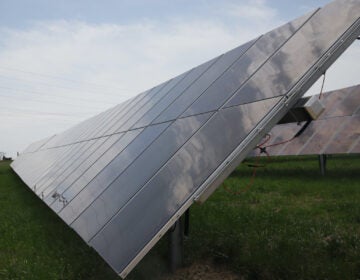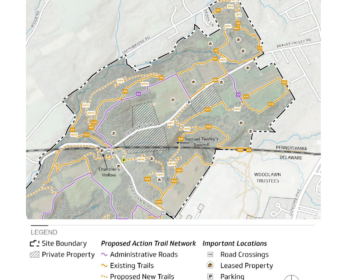Sussex County solar farm to power 750 homes, supporting Delaware’s clean energy targets
June 15, 2025
From Philly and the Pa. suburbs to South Jersey and Delaware, what would you like WHYY News to cover? Let us know!
For years, the energy powering Sussex County came from far beyond its borders — sent in through a vast network of infrastructure stretching across Delaware. But a new 9,000-module solar array built just off Trap Pond Road in Georgetown, Delaware marks a significant shift in how the state generates, distributes and democratizes electricity.
“We have very little in the way of generation in Sussex County,” said Democratic state Sen. Stephanie Hansen, who represents parts of Newcastle County.
Hansen said energy distribution from the solar farm will be much more efficient than relying on electricity sent from distant power plants.
“Most of the energy that we use comes from outside of our states, and most of the energy that we actually generate in-state comes from way north of here,” Hansen said. “That has to be transported down here … and it comes at, oftentimes, when it’s really hot, when it’s really cold — congestion pricing, where there are losses of the energy that you get from just traveling that distance.”
Now, with the launch of a new project by community solar developers Nautilus Solar Energy and TurningPoint Energy, Sussex County residents who wouldn’t have had access to rooftop solar can benefit from carbon-free energy and discounted rates. The site, located on a 35.6-acre property, will generate 4.7 megawatts of power and is surrounded by a 25-foot-wide landscaped buffer. It’s the first of six planned community solar installations that TurningPoint expects to develop, which would generate 30 megawatts of power across the state.
Power from the project will start flowing in a couple of months, benefitting roughly 750 households and small businesses. Low-income households will receive a 20% discount on their electric bills, while others will benefit from a 10% cut.
“Delaware did a very good job in how they designed this program,” said Eric LaMora, vice president of community solar for Nautilus. “Every project, at least 15% of the energy goes to benefit low-income households.”
Lamora said the company’s two other projects in the area will direct 50% of the power to Delmarva Power’s low-income customers.
Delaware’s community solar initiative is part of a broader climate strategy. Under its Climate Action Plan, the state has committed to sourcing 40% of its electricity from renewable sources by 2035 — including a dedicated goal of 10% from solar. It also aims to reduce net greenhouse gas emissions by 50% by 2030 and reach net-zero emissions by 2050.
The project’s financing benefited from federal solar tax credits, which expanded under the Biden administration to help jump-start the green energy economy and tackle climate change. The program permits community solar project developers to pass savings on to low-income customers.
“[The tax credits] allow us to leverage our capital to build more projects offering discounted electricity to a greater number of households and support the growing demand for electricity,” LaMora said.
A 5-year journey included new community solar legislation
Getting to this moment took years of effort.
“This really started back probably about five years ago or so,” Hansen explained, “when the solar industry came to those of us in the legislature and the administration and said, ‘We can’t build solar projects here … there are a lot of regulations and impediments and roadblocks to us doing it.’”

Community solar makes green energy available to residents who either can not afford, or do not have the ability, in the case of renters, to install rooftop solar. Those who subscribe to the projects get a reduction in their electricity bills.
But developers had faced barriers in the state, including limits on project size, strict customer identification requirements, and rules mandating that all customers be on the same distribution line. These made community solar projects economically and logistically unworkable in Delaware.
To address that, Hansen helped launch a community solar stakeholder group, consisting of developers, regulators, advocates and public officials.
“We put together a group … about two dozen or so of the folks in Delaware that actually know the most about energy policy,” Hansen said. “We listened to what the community solar development community had to say about what were all the impediments. And then we set out to write a bill.”
That bill became Senate Bill 2, which passed in 2021. It eliminated key roadblocks and directed the Public Service Commission to design and implement a workable program.
“Now, five years later, here we stand,” Hansen said.
But the future of these types of community solar projects could be shaped not only by state-level leadership, but also decisions in Washington, D.C. The budget bill passed by the U.S. House rolls back the federal tax credits that helped make this solar farm financially viable.
LaMora said if the solar tax credits are eliminated, it will slow down growth of the solar industry.
The tax credits have also led to a boom in rooftop solar, including projects on churches and schools. In states like Pennsylvania, school districts say their solar plans would stall without those credits, and developers warn of layoffs and project cancellations. Hence, for Delaware, the window to continue clean energy adoption — especially for underserved communities — may now be narrowing. Solar industry advocates are pushing for the U.S. Senate to save the credits in its version of the budget bill by phasing them out more slowly.

Get daily updates from WHYY News!
WHYY is your source for fact-based, in-depth journalism and information. As a nonprofit organization, we rely on financial support from readers like you. Please give today.
Search
RECENT PRESS RELEASES
Related Post








